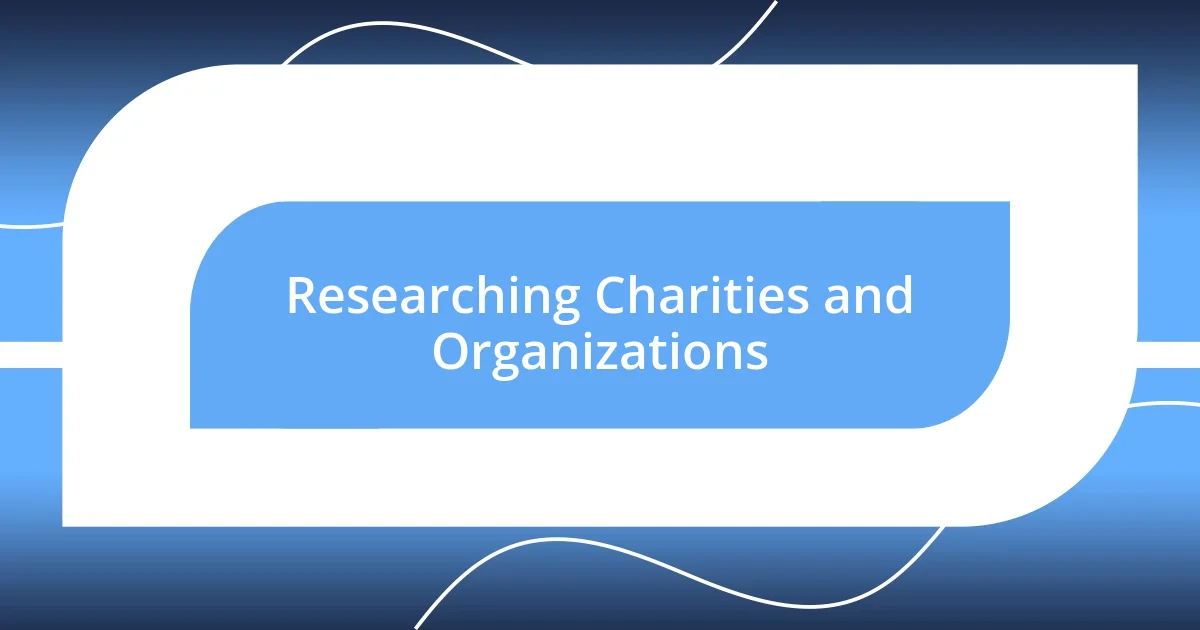Key takeaways:
- Engaging with charities that align with personal values creates a deeper emotional connection and greater fulfillment in giving.
- Establishing a charitable giving budget helps maintain financial balance while ensuring consistent support for chosen causes.
- Researching charities and tracking contributions enhances the giving experience by fostering informed decisions and personal connections to the impact made.

Understanding Charitable Giving Impact
When I think about the impact of charitable giving, I often reflect on the time I donated to a local food bank. It wasn’t just about the money; it was about seeing firsthand how that contribution transformed lives. How often do we overlook the tangible effects of our donations? Each dollar can be a lifeline, providing meals and support to those who truly need it.
Understanding the ripple effect of our generosity can sometimes feel overwhelming. The emotional weight of knowing that my small act of kindness has contributed to someone’s recovery or education is immeasurable. Have you ever considered how your contributions resonate not only at the moment but also in the long term? I’ve discovered that engaging with the organizations I support has deepened my understanding of their missions and enhanced my connection to the communities they serve.
The effectiveness of charitable giving can also depend on how well we align our values with those of the charities we choose. I’ve realized that when I give to causes that resonate deeply with me, the emotional fulfillment is far greater. This alignment creates a sense of partnership, making me feel like I’m part of something larger. Wouldn’t you agree that the most impactful giving comes from a place of genuine connection and shared purpose?

Identifying Personal Values and Causes
Identifying personal values and causes is a journey that can be quite revealing. I remember when I realized my passion for environmental conservation. It wasn’t just a fleeting interest; it sparked a fire in me that led to volunteering with local cleaning initiatives. This experience connected my values with real-world action, prompting me to contribute to organizations that are on the front lines of environmental protection.
In my experience, reflecting on the issues that resonate deeply within me has guided my charitable choices. For instance, supporting mental health initiatives became a priority after witnessing a friend struggle with depression. The more I learned about the challenges faced by individuals in this area, the more I felt compelled to contribute. This alignment between my values and the causes I support has enriched my giving experience profoundly—it’s not just about charity; it’s about creating lasting change.
I believe self-reflection is key. Take the time to ponder what truly matters to you. Consider aspects such as community development, health care, or education—areas where your contributions could create a meaningful impact. When you connect your values with your charitable giving, you not only empower those in need but also find greater joy and satisfaction in your contributions.
| Personal Values | Causes |
|---|---|
| Environmental Sustainability | Wildlife Conservation, Clean-up Initiatives |
| Mental Health Awareness | Support Groups, Educational Programs |
| Community Development | Local Nonprofits, Skill-Building Workshops |

Setting a Charitable Giving Budget
Setting a charitable giving budget is a vital step in ensuring that my contributions align with my financial reality and my philanthropic goals. I remember when I first treated this as a serious commitment rather than an occasional impulse. By mapping out my monthly expenses, I found a comfortable figure that allowed me to contribute without feeling financially strained. This simple exercise has not only brought clarity but also a greater sense of satisfaction when I donate.
To effectively set a charitable giving budget, I suggest considering these key points:
- Determine Your Income: Assess your overall income to understand how much you can realistically allocate to charity.
- Evaluate Expenses: Take a close look at your monthly expenses to identify areas where you can cut back to free up funds for giving.
- Prioritize Your Causes: Decide which causes are most important to you, and allocate more funds to those areas.
- Set a Specific Amount: Choose a specific monetary amount or percentage of your income dedicated to charitable giving each month.
- Review and Adjust Regularly: Life circumstances change, so regularly revisit your budget to make necessary adjustments.
By following these guidelines, creating a budget for charitable giving becomes a thoughtful act rather than a spontaneous one. I’ve found that this approach not only eases my mind, but it also allows me to engage more deeply with the organizations I support, ultimately creating a more fulfilling giving experience.

Exploring Different Giving Methods
Exploring different giving methods has opened my eyes to how I can make an impact in diverse ways. I’ve tried everything from direct donations to participating in fundraising events. I recall the excitement of attending a charity gala, not just for the social experience, but for the profound feeling of contributing to something bigger than myself while enjoying the camaraderie of like-minded individuals.
One method I find particularly rewarding is monthly giving. It offers a sense of consistency that resonates with my desire for long-term commitment. When I began this practice, I felt as if I had become part of a community, working together to achieve goals. Instead of a one-off donation, my involvement grew richer as I received updates on the projects I was supporting. Have you ever felt that deeper connection? It’s a beautiful transition from simply donating money to becoming a stakeholder in change.
Another approach I’ve explored is leveraging my skills. I remember tutoring students in math for a local nonprofit. Beyond monetary contributions, offering my time and expertise made me realize how valuable my involvement could be. The smiles on those students’ faces when they grasped a difficult concept were worth more than any financial donation I could make. This experience led me to question: how can your unique skills enhance the impact of your charitable efforts? I’ve learned that there’s so much more to giving than just writing a check; it’s about sharing who we are.

Researching Charities and Organizations
Researching charities and organizations is a crucial step in making informed decisions about where to direct my giving. I vividly remember the moment I stumbled upon a charity that aligned perfectly with my values. I was looking into environmental causes when I came across a grassroots organization focused on reforestation in my hometown. Digging deeper, I found their transparency impressive; they provided detailed financial reports and updates on their projects. Knowing that my contributions would go directly toward planting trees brought a sense of fulfillment I hadn’t experienced before.
One practice I adopt is cross-referencing multiple sources to gain a well-rounded view of a potential charity. For instance, I often check platforms like Charity Navigator and Guidestar, which rank organizations based on their financial health and accountability. It’s fascinating to see how different charities approach similar goals. Have you ever wondered how you could differentiate between them? I’ve learned that not all organizations are created equal, and that exploring their mission statements and reviews can shed light on their actual impact.
Another effective strategy is reaching out directly to the charity. I remember sending an email to a local shelter to ask about their programs and how they utilized donations. Their prompt and heartfelt response was eye-opening. It not only showcased their passion but also allowed me to understand the community they served. In those moments, I realized that engaging with organizations personally could deepen my connection and help me make a charitable decision that truly resonates with my heart. How often do you take that extra step to ensure your support goes to the right place? I find that building these connections elevates my giving experience from mere transactions to meaningful partnerships.

Tracking and Assessing Your Contributions
One effective way I’ve found to track my contributions is by keeping a dedicated spreadsheet. I’ve included columns for the charity name, date of donation, amount, and specific projects my funds supported. Let me tell you, the simple act of entering those details not only helped me stay organized but also gave me a tangible sense of pride when I reviewed my impact at the end of the year. Have you ever reflected on your giving? It’s a powerful reminder of the difference you’re making.
Assessing my contributions goes beyond numbers; it’s about the stories behind them. I remember feeling incredibly moved when I received a heartfelt thank-you letter from a charity I supported after their outreach program. They outlined how my funds helped buy supplies for underserved families in my community. That personal touch made the data on my spreadsheet come alive. Have you sought out stories like this? I’ve learned these narratives turn cold statistics into warm connections, reminding me of the real lives I’m impacting.
I also have a habit of revisiting my contributions annually, adjusting them based on the feedback I’m receiving from the organizations. Whether it’s word-of-mouth stories from volunteers or annual reports that detail the impact of my support, this practice helps me align my giving with causes that resonate more deeply with me each year. It’s like having a conversation with my philanthropic spirit; it evolves just as I do. Do you reevaluate your giving journey? Engaging in this reflective process fosters a more intentional approach to my charitable efforts, ensuring my contributions truly align with my values and the needs of the community.

Building a Sustainable Giving Plan
Building a sustainable giving plan starts with making a commitment that aligns with your values. I’ve found that setting a percentage of my income for charitable giving creates a sense of financial balance. For example, when I decided on 5%, it felt liberating. It allowed me to give consistently without the pressure of feeling like I’m giving too much or too little. Have you ever considered how a fixed percentage could reshape your giving experience?
One of the best practices I’ve adopted is committing to long-term support for a select number of organizations, rather than spreading my contributions too thin. I remember the first charity I decided to support annually: it was a local food bank fighting hunger in my community. By focusing my efforts, I could witness the tangible impact of my donations over time. It felt like being part of a family—a community united for a common cause. Isn’t it rewarding to see your contributions compound positively?
Planning for more than just monthly or annual giving has also enriched my charitable journey. I now consider unique opportunities such as matching gift programs or year-end campaigns, which can double my contributions and enhance my community impact. I vividly recall the excitement of discovering that my employer matched donations to one of my favorite charities. This additional support amplified my giving, and it taught me the importance of utilizing every resource available. Have you explored such matching opportunities? It’s these little insights that can elevate your giving plan from good to extraordinary.












